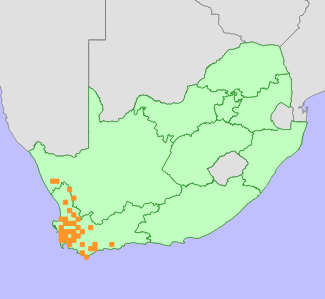|
Scientific Name | Eustegia minuta (L.f.) Schult. |
Higher Classification | Dicotyledons |
Family | APOCYNACEAE |
Synonyms | Apocynum filiforme L.f., Apocynum hastatum Thunb., Apocynum minutum L.f., Eustegia filiformis (L.f.) Schult., Eustegia fraterna N.E.Br., Eustegia fraterna N.E.Br. var. pubescens N.E.Br., Eustegia hastata (Thunb.) Spreng., Eustegia humilis E.Mey., Eustegia lonchitis E.Mey., Eustegia macropetala Schltr., Eustegia plicata Schinz |
Common Names | Dwarf Milkroof (e) |
National Status |
Status and Criteria | Least Concern |
Assessment Date | 2016/10/06 |
Assessor(s) | L. von Staden |
Justification | A widespread species that is becoming rarer over much of its range due to extensive habitat loss, fragmentation and degradation. It however does not yet meet any of the criteria for a category of threat. |
Distribution |
Endemism | South African endemic |
Provincial distribution | Northern Cape, Western Cape |
Range | Kamiesberg to the Cape Flats and the Overberg as far as Riversdale. |
Habitat and Ecology |
Major system | Terrestrial |
Major habitats | Fynbos |
Description | Clay flats and lower slopes. |
Threats |
| This species has declined extensively across its range, predominantly due to habitat loss to crop cultivation. In the Swartland, small subpopulations remain on isolated renosterveld fragments. It is now locally extinct over most of the Cape Flats due to habitat loss to urban expansion (Bruyns 1999). Also within the Overberg, which is extensively cultivated, only small fragments of lowland renosterveld remains intact. |
Population |
Plants are inconspicuous, and often found in very small subpopulations of fewer than 10 plants (Bruyns 1999). It can sometimes be locally common, such as in disturbed places along tracks, and after fires (Bruyns 1999). Flowering appears to be stimulated by fires, and large numbers of plants can be seen in the first two years after fires, where after flowering becomes more sporadic. This species has already lost more than 60% of its habitat, and continues to decline. A population reduction of at least 50% could be inferred from the extent of habitat loss, but possibly over a period of longer than three generations.
|
Population trend | Decreasing |
Assessment History |
Taxon assessed |
Status and Criteria |
Citation/Red List version | | Eustegia minuta (L.f.) Schult. | LC | 2017.1 | | Eustegia macropetala Schltr. | Threatened | Raimondo et al. (2009) | | Eustegia plicata Schinz | Threatened | Raimondo et al. (2009) | | Eustegia fraterna N.E.Br. var. pubescens N.E.Br. | Threatened | Raimondo et al. (2009) | | Eustegia minuta (L.f.) R.Br. | Least Concern | Raimondo et al. (2009) | | Eustegia filiformis (L.f.) Schult. | Least Concern | Raimondo et al. (2009) | | Eustegia fraterna N.E.Br. var. fraterna | Threatened | Raimondo et al. (2009) | |
Bibliography |
Brown, N.E. 1909. Asclepiadeae. In: W.T. Thiselton-Dyer (ed). Flora Capensis IV Section I (Vacciniaceae to Gentianeae):518-1036. Lovell Reeve & Co., Ltd., London.
Bruyns, P.V. 1999. The systematic position of Eustegia R.Br. (Apocynaceae - Asclepiadoideae). Botanische Jahrbücher für Systematik 121(1):19-44.
Goldblatt, P. and Manning, J.C. 2000. Cape Plants: A conspectus of the Cape Flora of South Africa. Strelitzia 9. National Botanical Institute, Cape Town.
Manning, J.C. and Goldblatt, P. 2012. Plants of the Greater Cape Floristic Region 1: The Core Cape Flora. Strelitzia 29. South African National Biodiversity Institute, Pretoria.
Nicholas, A. 1999. A taxonomic reassessment of the subtribe Asclepiadinae (Asclepiaceae) in Southern Africa. Unpublished Ph.D., University of Durban-Westville, Durban.
Raimondo, D., von Staden, L., Foden, W., Victor, J.E., Helme, N.A., Turner, R.C., Kamundi, D.A. and Manyama, P.A. 2009. Red List of South African Plants. Strelitzia 25. South African National Biodiversity Institute, Pretoria.
|
Citation |
| von Staden, L. 2016. Eustegia minuta (L.f.) Schult. National Assessment: Red List of South African Plants version . Accessed on 2025/08/20 |
 Comment on this assessment
Comment on this assessment

